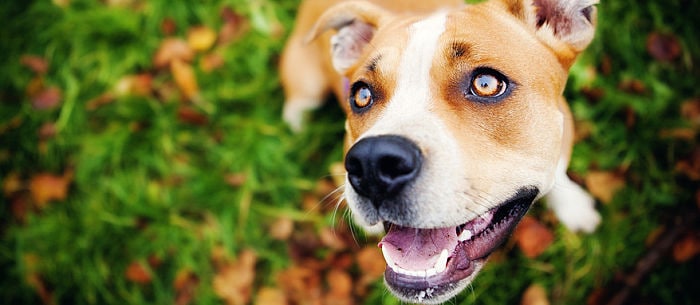When your dog wakes you up in the morning with a big kiss but his nose is wet and cold – is that a cause to worry? What about if it’s bumpy, runny or lacks pigment? Clues about a dog’s health might be sitting at the tip of … a dog nose. True or false?
It’s true, to some extent.
But pet owners or pet sitters shouldn’t solely rely on a dog’s nose as a barometer of health, says veterinarian Dr. Ann Hohenhaus of The Animal Medical Center in New York City and a diplomat of the American College of Veterinary Internal Medicine. ” In veterinary school, “there was never a lecture on nose moistness or temperature as a diagnostic tool,” she says with some jest.
Dr. Hohenhaus goes on to explain that healthy respiration through a dog nose should be quiet, and the texture of the nose should resemble a “pebbled leather handbag.” And while healthy dog noses vary, they are usually wet, dry, warm or cool.
So why do the temperature and moistness change? Veterinarian Peter Weinstein of PAW Consulting, who also serves as the executive director of the Southern California Veterinary Medical Association, says it’s simple. A dog’s nose may be wet because he licked his face or has tear secretions. Dry noses often occur when the pet sleeps. Dogs can’t sweat, he explains. They thermo-regulate their bodies in part through evaporation via their noses, which causes a wet-dry cycle.
Have a dog nose to worry about? While it’s true that you can’t rely solely upon a nose to determine a dog’s health there are things it can tell you.Drs. Hohenhaus and Weinstein cite these types of dog noses to watch out for:
- Blood
When you notice blood, the pet may have a tumor inside the nose, an abscessed tooth, fungal infection, blood clotting problems or a bleeding disorder. Wipe away the drips, and if you don’t see a small cut, assume it’s time to follow up with a vet.
- Ulcerations
Are there deep cuts visible on the nose? The dog may have an immune skin disease, tumor or have been exposed to a caustic agent, such as household cleansers.
- Cracks
If you notice shallow cracks, the dog’s nose may be dry from cold winter air or dry summer weather. Deeper cracks may indicate an immune condition or infection.
- Loss of Pigment
It’s not uncommon for the color of a dog’s nose to change slightly. It can be caused by using plastic feed dishes, due to a reaction to a melatonin-affecting chemical in the plastic, and can occur naturally during cold weather. However, loss of nose pigment may indicate an immune system disorder or tumor.
- Bumpy
Is there a raised area on the dog nose? The lump may be a tumor. Squamous cell carcinoma (cancer) in the upper jaw often develops in the mouth and under the nose, causing the outer part of the nose to swell. Dogs with light-colored noses who are often exposed to sun are at the highest risk of this.
- Swollen
If you notice inflammation in a dog’s nose, there could be many reasons for it. Everything from allergies and insect bites to abscessed teeth or a porcupine quill lodged in the nose could cause swelling. Look for something obvious, such as a broken quill, and follow up with your vet in case of infection.
- Sneezing
If the pet sneezes often or produces a honking sound, he may have allergies, an upper respiratory infection or an object lodged inside his nose. If the pet has a difficult time breathing, visit the vet immediately.
- Runny
When clear liquid drips from the nose, the pet may have allergies to food or something in the environment, such as weeds. Canine influenza and bordetella also produce clear discharge in abundance. When the nasal discharge turns yellow or cloudy, an infection or foreign object lodged in the nose might be the cause.
- Rubbing
If a dog paws at his nose, rubs it against furniture or has noisy respiration, there may be a less visible problem, such as a foreign object or mass inside the nasal cavity, according to Dr. Hohenhaus.
When to Visit the Vet
If you’re concerned about your pet’s health, call the vet. Most allergy-related issues can be remedied with decongestants and antihistamines. Some pets may require dietary or environmental changes. Noses with infections will need oral or topical antibiotics. For pets with conditions caused by chronic dryness, moisturizing nose balms and humidifiers can help.
“If there is an abnormal discharge (not clear — especially blood), unrelenting sneezing, excessive pawing at the nose, loss of pigmentation or the surface is crusty or cracking, a veterinary visit is warranted,” Dr. Weinstein stresses. “The nose alone should not be a cause to bring a dog to the vet. However, if the nose is dry and there are other signs that the pet is not feeling well, action should be taken,” he adds.
Curious about how to keep your dog’s mouth healthy? Check out Just What the Doctor Ordered — Dental Hygiene and Home Safety for Your Pet.
Angela Tague writes about parenting, pet care and being a home-based writer. She and her husband live in Iowa with their two spoiled dogs.
